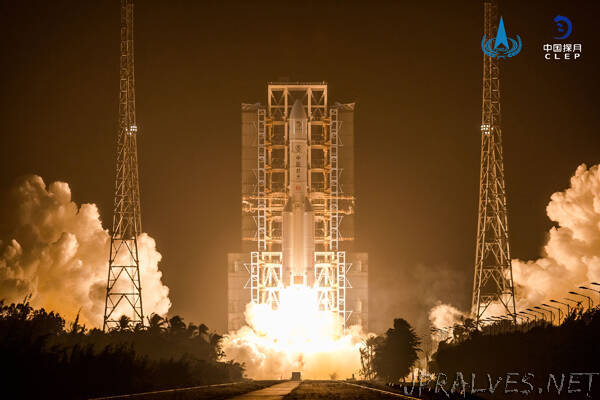
“China launched a large robotic spacecraft early Tuesday morning at the Wenchang Space Launch Center in South China’s Hainan province, tasking it with landing on the moon and bringing back lunar samples, 44 years after the last time such extraterrestrial substances were brought back to Earth.
A Long March 5 heavy-lift carrier rocket, the biggest and mightiest launch vehicle in China, lifted its 20-story-tall body and soared skyward trailing a spectacular silver flame at 4:30 am from its launch pad, leaving many spectators inside and around the coastal Wenchang center in awe and excitement as the gigantic booster thundered skyward.
The rocket was tasked with placing the 8.2-metric ton Chang’e 5, which has four components — orbiter, lander, ascender and re-entry capsule — in an Earth-moon transfer trajectory.
China launches Long March 5 heavy-lift carrier rocket at the Wenchang Space Launch Center in South China’s Hainan province on Nov 24 early morning. [XU JINGXING / CHINA DAILY]
The heaviest and largest in the nation’s lunar probe fleet, Chang’e 5 will fly in the trajectory within the next several days and make some correction operations before conducting a key braking maneuver to avoid accidentally flying past the moon.
After its arrival in lunar orbit, the probe will fly around the celestial body for a certain period of time and will then separate into two parts, with the orbiter and re-entry capsule remaining in orbit while the lander-ascender combination descending to the lunar surface.
The landing combination will make an engine-assisted touchdown on the moon and later conduct such assignments as using a cutting-edge drill to obtain underground rocks from 2 meters beneath the surface and a mechanical arm to gather surface dirt.
If everything proceeds smoothly, about 2 kilograms of stones and soil will be collected and packed in a vacuum metal container inside the ascender.
China launches Long March 5 heavy-lift carrier rocket at the Wenchang Space Launch Center in South China’s Hainan province on Nov 24 early morning. [XU JINGXING / CHINA DAILY]
After the two-day surface operations are done, the ascender’s rocket will elevate it to lunar orbit to rendezvous and dock with the re-entry module. It will transfer lunar samples to the module and then undock from the latter.
The combination of orbiter and re-entry capsule will then depart the lunar orbit and return to Earth’s orbit, where the pair will break up and the re-entry capsule will conduct a host of complicated maneuvers to return to a preset landing site in North China’s Inner Mongolia autonomous region in mid-December.
Back on the lunar surface, the lander will continue using its three scientific payloads to carry out survey and measurement — the panoramic camera is tasked with mapping the topography of the landing site; the infrared spectrometer will determine the physical composition of stones and dirt around the landing site; and the soil measurement instrument will detect and analyze the subsurface structure of the drilling point.
The entire mission is scheduled to last about 23 days, according to the China National Space Administration.
Considering these highly sophisticated operations, Chang’e 5 will be more difficult and challenging than previous Chinese lunar expeditions, designers have said.
If the Chang’e 5 mission ends successfully, it will become China’s first space activity to retrieve extraterrestrial substance and also will make China the third nation in the world to bring lunar samples back after the United States and the former Soviet Union.
Moreover, the mission’s success will make Chang’e 5 the world’s first lunar sample-return spacecraft since August 1976, when the former Soviet Union’s unmanned Luna 24 brought 170.1 grams of lunar samples to the Earth.
Chang’e 5, China’s heaviest and largest lunar probe. [PROVIDED TO CHINA DAILY]
According to a statement published by the space administration, the Chang’e 5 mission is intended to fulfill several objectives. In terms of space engineering, it will demonstrate and verify technical plans and apparatus for autonomous lunar sampling and packing, and moon-based launching, as well as lunar orbital docking. In the scientific field, it will investigate the landing site’s geological and topographic features, and enable scientists to analyze the lunar samples’ structure and physical traits so they can deepen their research into the moon’s origin and evolution.
It added that the mission also will help to foster the country’s knowledge, technology and talent pool for its future manned missions to the moon and other deep-space expeditions.
Pei Zhaoyu, spokesman for the Chang’e 5 mission, said if the mission becomes successful, it will be a milestone in the nation’s lunar exploration endeavor and will show the world China’s scientific, technological and engineering capabilities.
Furthermore, Chang’e 5 will strengthen the nation’s status and influence in the international space community, pave the way for the country’s future lunar expeditions and boost its space science, and will offer more opportunities to lunar researchers around the world, he said.
Scientists around the world are welcome to participate in the research related to the lunar samples brought back by the mission. China will publish a set of guidelines about the use and distribution of the samples after the mission, said Pei, who is deputy director of the administration’s Lunar Exploration and Space Program Center.(Chinadaily)”
